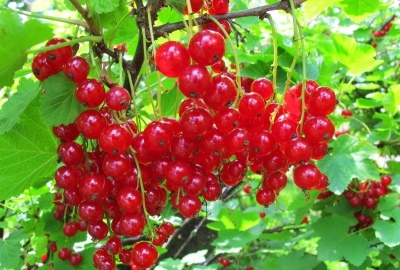
- Authors: D. A. Andreichenko, I. V. Shpileva, A. I. Degtyareva (Novosibirsk zonal fruit and berry experimental station named after I. V. Michurin)
- Appeared when crossing: obtained by selection among seedlings from free pollination of the Red Cross variety
- Name synonyms: Ribes rubrum Andreichenko
- Year of approval: 1987
- Ripening terms: average ripening
- Growth type: vigorous
- Yield: high
- Appointment: universal
- Berry weight, g: 0,57-0,8
- Tasting assessment: 4,2
The first experiments on planting this variety were carried out back in the late 80s of the twentieth century in the regions that turned out to be the most suitable for the good development of bushes - the Urals, Siberia and the Middle Volga. Red currant Andreichenko has always been extremely popular in a large post-Soviet territory due to its amazingly high winter hardiness. And today she has not lost her position.
Breeding history
The history of the Krasnaya Andreichenko currant culture dates back to the middle of the last century. Initially, the natural pollination of one of the red currant varieties was noticed by the employees of the Novosibirsk Zonal Fruit and Berry Experimental Station named after N.N. IV Michurin, and then its leading experts DA Andreichenko, IV Shpileva, AI Degtyareva were already working. The variety was obtained by the method of selection of seedlings from free pollination of the Red Cross variety, and the culture was named after one of the authors. The people also call this currant Dear, the official synonym is Ribes rubrum Andreichenko.
Variety trials began in 1985, and already in 1987 the variety was added to the State Register in several regions.
Description of the variety
The Krasnaya Andreichenko bush is distinguished by its average height, it can stretch up to 150 centimeters. The shape of the plant is round, spreading is weak. Shoots are of medium thickness, but not brittle. The foliage is small, rather medium in size, colored in a light green tone. At the same time, the leaves are dull, slightly wrinkled, the edges are raised, there is a slight concavity along the veins. Quite long brushes (up to 8 centimeters) have 5 to 7 berries.
Characteristics of berries
Currants have medium-sized fruits, each weighing from 0.57 to 0.8 grams. They are round in shape. The color of the berries is bright red, ripening is amicable.
Taste qualities
Red currant Andreichenko belongs to universal products. They note a good, sweet and sour taste, juiciness.
The fruits contain:
- soluble solids - 11.7%;
- sugars - 6.8%;
- titratable acids - 1.7%;
- ascorbic acid (vitamin C) - 40.9 mg / 100 g;
- catechins - 550.9 mg / 100 g.
The tasters rated the taste of the currant at 4.2 points out of 5.
Ripening and fruiting
The currant of the described variety belongs to crops with an average ripening period. You can harvest in mid-July. The variety is fast-growing and begins to bear fruit early.

Yield
The high yield of Red Andreichenko is noted. So, from one hectare, farms collect up to 8.1 tons.In personal subsidiary plots, up to 5-6 kilograms of berries can be removed from the bush.
Growing regions
The variety is zoned in several regions with difficult climatic conditions. Krasnaya Andreichenko takes root well in the Middle Volga, in the Urals, in Western and Eastern Siberia.
Landing
For the landing of Krasnaya Andreichenko, you should choose a place open to the sun, at the same time protected from strong and cold winds. The soil is suitable light - loamy or sandy loam, slightly acidic. Currants love moisture, therefore, a close location of groundwater is possible.
The size of the planting hole will depend on the age of the seedling. Most often, a hole is prepared with dimensions of 50x50 centimeters so that the roots are spacious. It is better to plant a crop in early autumn. When planting several seedlings, the optimal distance between the bushes will be 1.5-2 m.

Growing and care
Caring for Krasnaya Andreichenko is not very difficult. It includes standard activities:
- regular watering (about once every 7 days);
- loosening the soil;
- fertilization (2 times a year).
With a lack of moisture, the berries will not be poured in full and may even decrease in size.
In early spring, when the snow melts, they bring mineral and organic fertilizing under the bushes. In the fall, one organic matter is left.
At one time, the culture was loved for its endurance in relation to winter frosts. And indeed, the variety is not afraid of low temperatures. However, experienced gardeners still advise placing a layer of organic matter around the trunk to warm the root system.





Currant is one of the most favorite crops of gardeners, it can be found on almost any personal plot. In order for the currant berries to be tasty and large, and the bush itself to be healthy and strong, you should properly care for, treat and protect the plant from harmful insects. It is important to recognize the signs of the disease in a timely manner and begin treatment in the early stages of plant damage.
Resistance to adverse climatic conditions
Due to the fact that the variety was specially developed for areas with risky farming, areas where winters are warm are completely unsuitable for Krasnaya Andreichenko. The culture doesn't like heat or drought. Currants will feel best in areas with a harsh climate.High winter hardiness is genetically inherent, the plant is characterized by deep organic dormancy, and the rudiments of flowers do not suffer at all from temperature extremes in winter.










































































